The State of the Art of Topologies for Electric Springs
Abstract
:1. Introduction
2. Single-Phase ESs
2.1. ES and Its Operating Principle
2.2. Existing Topology of ES-1 and ES-2
- (1)
- Inductive power compensation;
- (2)
- Capacitive power compensation;
- (3)
- Resistive compensation.
- (1)
- Inductive power compensation (Figure 4a);
- (2)
- Capacitive power compensation (Figure 4b);
- (3)
- Positive real power compensation (Figure 4c);
- (4)
- Negative real power compensation (Figure 4d);
- (5)
- Inductive plus positive real power compensation (Figure 5a);
- (6)
- Inductive plus negative real power compensation (Figure 5b);
- (7)
- Capacitive plus positive real power compensation (Figure 5c);
- (8)
- Capacitive plus negative real power compensation (Figure 5d).
2.3. Existing Topology of ES-3
2.4. Existing Topology of Modified ES-2
2.5. Existing Topology of Isolated ES-2
2.6. Existing Topology of CSI-ES
- (1)
- VSI is replaced by CSI;
- (2)
- Filter inductor after the inverter is removed.
2.7. Existing Topology of SLBC
2.8. Summary of Single-Phase ES
- (1)
- The only difference between ES-1 and ES-2 is that the input components of VSIs are capacitor in ES-1 whilst voltage source or batteries in ES-2;
- (2)
- ES-3 is the bi-directional AC/DC converter with batteries in the DC side, without NCL at all;
- (3)
- Modified ES-2 is a kind of modified version of ES-2;
- (4)
- Isolated ES-2 is the full-isolated version of ES-2;
- (5)
- In CSI-ES, VSI has been replaced by CSI;
- (6)
- The difference between SLBC and ES-2 is that voltage source and/or batteries in ES-2 have been replaced by bi-directional PWM rectifier in SLBC.
3. Three-Phase ESs
3.1. Existing Topology of TPES-1
3.2. Existing Topology of TPES-2
3.3. Existing TPES-3 Topologies
3.4. Existing Topology of TPES-4
3.5. Summary of Three-Phase ESs
- (1)
- TPES-1 is the basic topology, an extension of ES-2;
- (2)
- TPES-2 is an extension of Modified ES-2;
- (3)
- TPES-3 is an extension of Isolated ES-2;
- (4)
- TPES-4 is a simplified version, which achieves the same function if using a three-phase PWM rectifier to replace the batteries in TPES-1.
4. DCESs
4.1. Existing Topology of DCES-1
4.2. Existing Topology of DCES-2
4.3. Other Configurations of DCES
4.4. Summary of DCESs
- (1)
- Volume and cost of filter is much lower;
- (2)
- Power density is higher;
- (3)
- DC/DC converters instead of DC/AC inverters.
5. Comparison between ES and Other FACTS Devices
5.1. Comparison with SSSC
5.2. Comparison with STATCOM
5.3. Comparison with UPFC
5.4. Comparison with APF
5.5. Summary
6. Conclusions
- (1)
- For the single-phase ESs, four additional topologies are analyzed besides the initial three versions, pointing out that each topology has its own advantages and disadvantages.
- (2)
- For the TPESs, the initial topology sequenced as TPES-1, is described firstly. Then, another two kinds of topologies such as TPES-2 and TPES-3 are analyzed, which are extended from modified ES-2 and Isolated ES-2, respectively. A new version realized by a nine-switch topology is described which is sequenced as TPES-4.
- (3)
- For the DCESs, three kinds of topologies are discussed, of which the one sequenced as DCES-1 has the same structure as ES-2, the one sequenced as DCES-2 is realized by complicated DC/DC converters, and the third one called PVES is a new configuration sharing a part of PV batteries with DCES topologies. The prominent advantage of DCES-2 over DCES-1 is its higher power density.
- (1)
- Great interest will be seen in the topology improvement of single-phase ESs. One of the trends is that ES-2 in fact is a series compensator, which is not consistent with traditional connection way of electric loads in power systems, especially for NCLs. For this matter, a new topology of single-phase ES could be one of the directions that not only can realize existing functionalities, but also can improve existing connecting configuration.
- (2)
- Another trend is that although Modified ES-2s achieve some progress compared to ES-2s, the side effect that the nominal voltage class of the NCL becomes lower occurs. As a result, how to improve the Modified ES-2 could be the possible study direction.
- (3)
- The third trend is that current ES-3 has no NCL in the topology which offers a chance for further improvement.
- (4)
- The fourth direction is to improve the power density of Isolated ES-2 while keeping full isolation among CLs, SLs and input voltage sources.
- (5)
- The final trend but also the most important trend for single-phase ES is to find a possible solution for SLBC to make it suitable for the islanded operation with long-time and frequent power sag. Meanwhile, the power management strategy inside the ESs should be considered.
- (6)
- Other trends include topology improvement in TPESs and DCESs.
Author Contributions
Funding
Conflicts of Interest
References
- Cheng, M.; Zhu, Y. The state of the art of wind energy conversion systems and technologies: A review. Energy Convers. Manag. 2014, 88, 332–347. [Google Scholar] [CrossRef]
- Deng, F.; Zhu, R.; Liu, D.; Wang, Y.; Wang, H.; Chen, Z.; Cheng, M. Protection scheme for modular multilevel converters under diode open-circuit faults. IEEE Trans. Power Electron. 2018, 33, 2866–2877. [Google Scholar] [CrossRef]
- Sotoodeh, P.; Miller, R.D. Design and implementation of an 11-level inverter with FACTS capability for distributed energy systems. IEEE J. Emerg. Sel. Top. Power Electron. 2014, 2, 87–96. [Google Scholar] [CrossRef]
- Dionise, T.J. Assessing the performance of a static var compensator for an electric arc furnace. IEEE Trans. Ind. Appl. 2014, 50, 1619–1629. [Google Scholar] [CrossRef]
- Du, S.; Liu, J.; Lin, J.; He, Y. A novel DC voltage control method for STATCOM based on hybrid multilevel H-Bridge converter. IEEE Trans. Power Electron. 2013, 28, 101–111. [Google Scholar] [CrossRef]
- Rai, D.; Faried, S.O.; Ramakrishna, G.; Edris, A.A. An SSSC-based hybrid series compensation scheme capable of damping subsynchronous resonance. IEEE Trans. Power Deliv. 2012, 27, 531–540. [Google Scholar] [CrossRef]
- Ebrahimzadeh, E.; Farhangi, S.; Iman-Eini, H.; Ajaei, F.B.; Iravani, R. Improved phasor estimation method for dynamic voltage restorer applications. IEEE Trans. Power Deliv. 2015, 30, 1467–1477. [Google Scholar] [CrossRef]
- Peng, F.; Liu, Y.; Yang, S.; Zhang, S.; Gunasekaran, D.; Karki, U. Transformer-less unified power-flow controller using the cascade multilevel inverter. IEEE Trans. Power Electron. 2016, 31, 5461–5472. [Google Scholar] [CrossRef]
- Dragicevic, T.; Lu, X.; Vasquez, J.C.; Guerrero, J.M. DC-microgrids—Part II: A review of power architectures applications and standardization issues. IEEE Trans. Smart Grid 2016, 31, 3528–3549. [Google Scholar] [CrossRef]
- Ding, Z.; Yang, C.; Zhang, Z.; Wang, C.; Xie, S. A novel soft-switching multiport bidirectional DC-DC converter for hybrid energy storage system. IEEE Trans. Power Electron. 2014, 29, 1595–1609. [Google Scholar] [CrossRef]
- Hredzak, B.; Agelidis, V.G.; Jang, M. A model predictive control system for a hybrid battery-ultra capacitor power source. IEEE Trans. Power Electron. 2014, 29, 1469–1479. [Google Scholar] [CrossRef]
- Hui, S.Y.R.; Lee, C.K.; Wu, F. Electric springs—A new smart grid technology. IEEE Trans. Smart Grid 2012, 3, 1552–1561. [Google Scholar] [CrossRef]
- Guerrero, J.M.; Vasquez, J.C.; Matas, J.; Matas, J.; de Vicuna, L.G.; Castilla, M. Hierarchical control of droop-controlled AC and DC microgrids—A general approach toward standardization. IEEE Trans. Ind. Electron. 2011, 58, 158–172. [Google Scholar] [CrossRef]
- Xie, C.; Zhao, X.; Li, K.; Zou, J.; Josep, M.G. A new tuning method of multi-resonant current controllers for grid-connected voltage source converters. IEEE J. Emerg. Sel. Top. Power Electron. 2018. [Google Scholar] [CrossRef]
- Sheikhi, A.; Rayati, M.; Bahrami, S.; Mohammad, A. Integrated demand side management game in smart energy hubs. IEEE Trans. Smart Grid 2015, 6, 675–683. [Google Scholar] [CrossRef]
- Lee, C.K.; Hui, S.Y.R. Reduction of energy storage requirements in future smart grid using electric springs. IEEE Trans. Smart Grid 2013, 4, 1282–1288. [Google Scholar] [CrossRef]
- Lee, C.K.; Cheng, K.L.; Ng, W.M. Load characterisation of electric spring. In Proceedings of the IEEE Energy Conversion Congress and Exposition (ECCE), Denver, CO, USA, 15–19 September 2013; pp. 4665–4670. [Google Scholar]
- Tan, S.C.; Lee, C.K.; Hui, S.Y.R. General steady-state analysis and control principle of electric springs with active and reactive power compensations. IEEE Trans. Power Electron. 2013, 28, 3958–3969. [Google Scholar] [CrossRef]
- Lee, C.K.; Hui, S.Y.R. Input AC voltage control bi-directional power converters. U.S. Patent 13,907,350, 31 May 2013. [Google Scholar]
- Wang, Q.; Cheng, M.; Chen, Z.; Buja, G. A novel topology and its control of single-phase electric springs. In Proceedings of the International Conference on Renewable Energy Research and Applications, Palermo, Italy, 22–25 November 2015; pp. 267–272. [Google Scholar]
- Wang, Q.; Cheng, M.; Buja, G. Integration of electric springs and multi-port transformers—A new solution for AC microgrids with renewable energy sources. Energies 2017, 10, 193. [Google Scholar] [CrossRef]
- Wang, Q.; Cheng, M.; Jiang, Y. Harmonics suppression for critical loads using electric springs with current-source inverters. IEEE J. Emerg. Sel. Top. Power Electron. 2016, 4, 1362–1369. [Google Scholar] [CrossRef]
- Yan, S.; Tan, S.C.; Lee, C.K.; Hui, S.Y.R. Reducing three-phase power imbalance with electric springs. In Proceedings of the IEEE International Symposium on Power Electronics for Distributed Generation Systems (PEDG), Galway, Ireland, 24–27 June 2014; pp. 1–7. [Google Scholar]
- Yan, S.; Tan, S.C.; Lee, C.K.; Chaudhuri, B.; Hui, S.Y.R. Electric springs for reducing power imbalance in three-phase power systems. IEEE Trans. Power Electron. 2015, 30, 3601–3609. [Google Scholar] [CrossRef]
- Wang, P.; Xiao, J.; Setyawan, L. Hierarchical control of hybrid energy storage system in DC microgrids. IEEE Trans. Ind. Electron. 2015, 62, 4915–4924. [Google Scholar]
- Diaz, N.L.; Dragicevic, T.; Vasquez, J.C.; Guerrero, J.M. Intelligent distributed generation and storage units for DC microgrids—A new concept on cooperative control without communications beyond droop control. IEEE Trans. Smart Grid 2014, 5, 2476–2485. [Google Scholar] [CrossRef]
- Rani, B.I.; Bango, G.S.; Nagamani, C. Control strategy for power flow management in a PV system supplying DC loads. IEEE Trans. Ind. Electron. 2013, 60, 3185–3194. [Google Scholar] [CrossRef]
- Mok, K.T.; Wang, M.H.; Tan, S.C.; Hui, S.Y.R. DC electric springs—An emerging technology for DC grids. In Proceedings of the IEEE Applied Power Electronics Conference and Exposition (APEC), Charlotte, NC, USA, 15–19 March 2015; pp. 684–690. [Google Scholar]
- Wang, Q.; Cheng, M.; Chen, Z.; Deng, F.; Wang, Z. DC electric springs with DC/DC converters. In Proceedings of the IEEE International Power Electronics and Motion Control Conference (IPEMC-ECCE Asia), Hefei, China, 22–25 May 2016; pp. 3268–3273. [Google Scholar]
- Wang, Q.; Cheng, M.; Chen, Z.; Wang, Z. Steady-state analysis of electric springs with a novel δ control. IEEE Trans. Power Electron. 2015, 30, 7159–7169. [Google Scholar] [CrossRef]
- Yang, T.; Mok, K.T.; Tan, S.C.; Hui, S.Y.R. Control of electric springs with coordinated battery management. In Proceedings of the IEEE Energy Conversion Congress and Exposition (ECCE), Montreal, QC, Canada, 20–24 September 2015; pp. 4740–6746. [Google Scholar]
- Pozzebon, G.G.; Machado, R.Q.; Buso, S.; Spiazzi, G. A grid-connected multilevel converter for interfacing PV arrays and energy storage devices. In Proceedings of the IEEE Industrial Electronics Society Annual Conference, Vienna, Austria, 10–13 November 2013; pp. 6158–6163. [Google Scholar]
- Li, K.; Xu, H.; Ma, Q.; Zhao, J. Hierarchy control of power quality for wind-battery energy storage system. IET Power Electron. 2014, 7, 2123–2132. [Google Scholar] [CrossRef]
- Wang, W.; Duan, J.; Wu, F.; Sun, L.; Wang, S. DC-bus hybird energy storage devices cooperation control strategy for stand-along inverter under imbalance load. In Proceedings of the International Conference on Electrical Machines and Systems (ICEMS), Hangzhou, China, 22–25 October 2014; pp. 295–301. [Google Scholar]
- Chien, L.J.; Chen, C.C.; Chen, J.F.; Hsieh, Y.P. Novel three-port converter with high-voltage gain. IEEE Trans. Power Electron. 2014, 29, 4693–4703. [Google Scholar] [CrossRef]
- Strunz, K.; Abbasi, E.; Huu, D.N. DC microgrid for wind and solar power integration. IEEE J. Emerg. Sel. Top. Power Electron. 2014, 2, 115–126. [Google Scholar] [CrossRef]
- Serban, I. Power decoupling method for single-phase H-bridge inverters with no additional power electronics. IEEE Trans. Ind. Electron. 2015, 62, 4805–4813. [Google Scholar] [CrossRef]
- Judewicz, M.G.; Gonzalez, S.A.; Echeverria, N.I.; Fischer, J.R.; Carria, D.O. Generalized predictive current control (GPCC) for grid-tie three-phase inverters. IEEE Trans. Ind. Electron. 2016, 63, 4475–4484. [Google Scholar] [CrossRef]
- Gong, Z.; Wu, X.; Dai, P.; Zhu, R. Modulated model predictive control for MMC-based active front-end rectifiers under unbalanced grid conditions. IEEE Trans. Ind. Electron. 2018. [CrossRef]
- Li, K.; Li, M.; Liang, Z.; Dong, Z.; Tian, S. Analytical closed-form expressions of DC current ripple for three-level neutral point clamped inverters with space-vector pulse-width modulation. IET Power Electron. 2016, 9, 930–937. [Google Scholar]
- Lee, C.K.; Chaudhuri, B.; Hui, S.Y.R. Hardware and control implementation of electric springs for stabilizing future smart grid with intermittent renewable energy sources. IEEE J. Emerg. Sel. Top. Power Electron. 2013, 1, 18–27. [Google Scholar] [CrossRef]
- Zou, Z.; Zhou, K.; Wang, Z.; Cheng, M. Frequency-adaptive fractional-order repetitive control of shunt active power filters. IEEE Trans. Ind. Electron. 2015, 62, 1659–1668. [Google Scholar] [CrossRef]
- Zhu, W.; Zhou, K.; Cheng, M.; Peng, F. A high-frequency-link single-phase PWM rectifier. IEEE Trans. Ind. Electron. 2015, 62, 289–298. [Google Scholar] [CrossRef]
- Akhtar, Z.; Chaudhuri, B.; Hui, S.Y.R. Smart loads for voltage control in distribution networks. IEEE Trans. Smart Grid 2017, 8, 937–946. [Google Scholar]
- Jin, J.; Chen, X. Cooperative operation of superconducting fault-current-limiting cable and SMES system for grounding fault protection in a LVDC network. IEEE Trans. Ind. Appl. 2015, 51, 5410–5414. [Google Scholar] [CrossRef]
- Liu, H.; Lee, C.K.; Hui, S.Y.R.; Waffenschmidt, E. Capability analysis and design considerations of electric springs. In Proceedings of the IEEE International Symposium on Power Electronics for Distributed Generation Systems (PEDG), Vancouver, BC, Canada, 27–30 June 2016; pp. 1–6. [Google Scholar]
- Wang, Q.; Cheng, M.; Jiang, Y.; Deng, F.; Chen, Z.; Buja, G. Control of three-phase electric springs used in microgrids under ideal and non-Ideal conditions. In Proceedings of the IEEE Industrial Electronics Society Annual Conference (IECON), Florence, Italy, 24–27 October 2016; pp. 2247–2252. [Google Scholar]
- Wang, Q.; Cheng, M.; Jiang, Y.; Deng, F.; Buja, G.; Wang, Y.; Chen, Z. Novel topology of three-phase electric spring and its control. In Proceedings of the IEEE Industrial Electronics Society Annual Conference (IECON), Beijing, China, 29 October–1 November 2017; pp. 2600–2605. [Google Scholar]
- Rauf, A.M.; Khadkikar, V.; Elmoursi, M.S. An integrated system configuration for electric springs to enhance the stability in future smart grid. In Proceedings of the Modern Electric Power Systems (MEPS), Wroclaw, Poland, 6–9 July 2015; pp. 1–5. [Google Scholar]
- Wang, M.; Tan, S.C.; Lee, C.K.; Hui, S.Y.R. A configuration of storage system for DC microgrids. IEEE Trans. Power Electron. 2018, 33, 3722–3733. [Google Scholar] [CrossRef]
- Luo, X.; Akhtar, Z.; Lee, C.K.; Chaudhuri, B.; Tan, S.C.; Hui, S.Y.R. Distributed voltage control with electric springs: Comparison with STATCOM. IEEE Trans. Smart Grid 2015, 6, 209–219. [Google Scholar] [CrossRef]
- Bangash, K.N.; Farrag, M.E.A.; Osman, A.H. Smart control of on load tap changer deployed in low voltage distribution network. In Proceedings of the International Conference on Electric Power and Energy Conversion Systems (EPECS), Sharjah, UAE, 24–26 November 2015; pp. 1–6. [Google Scholar]
- Subramani, C.; Ramanand, K.R. A brief review on electric spring: Analysis, control and applications. J. Circuits Syst. Comput. 2017, 27, 183002. [Google Scholar] [CrossRef]
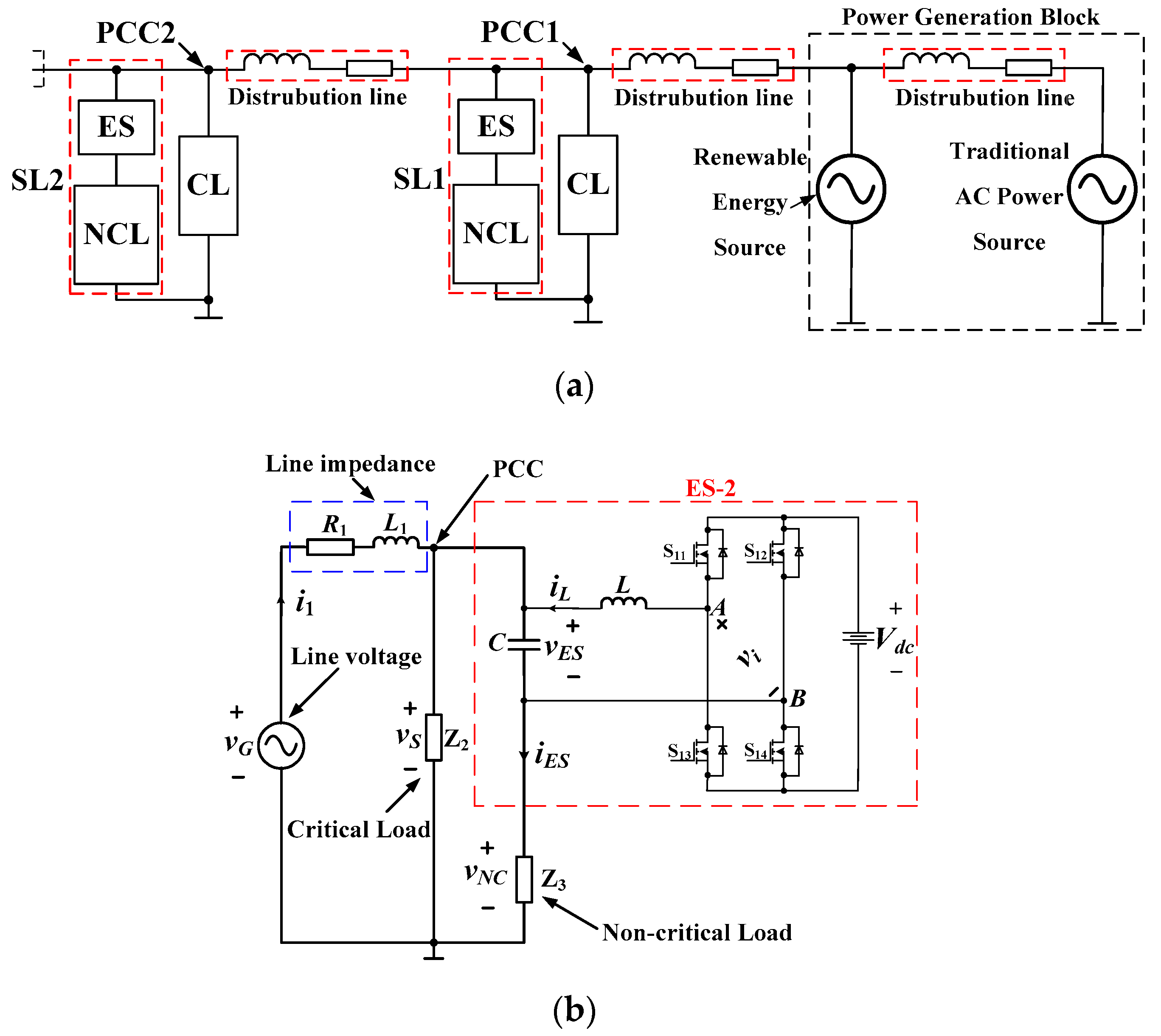
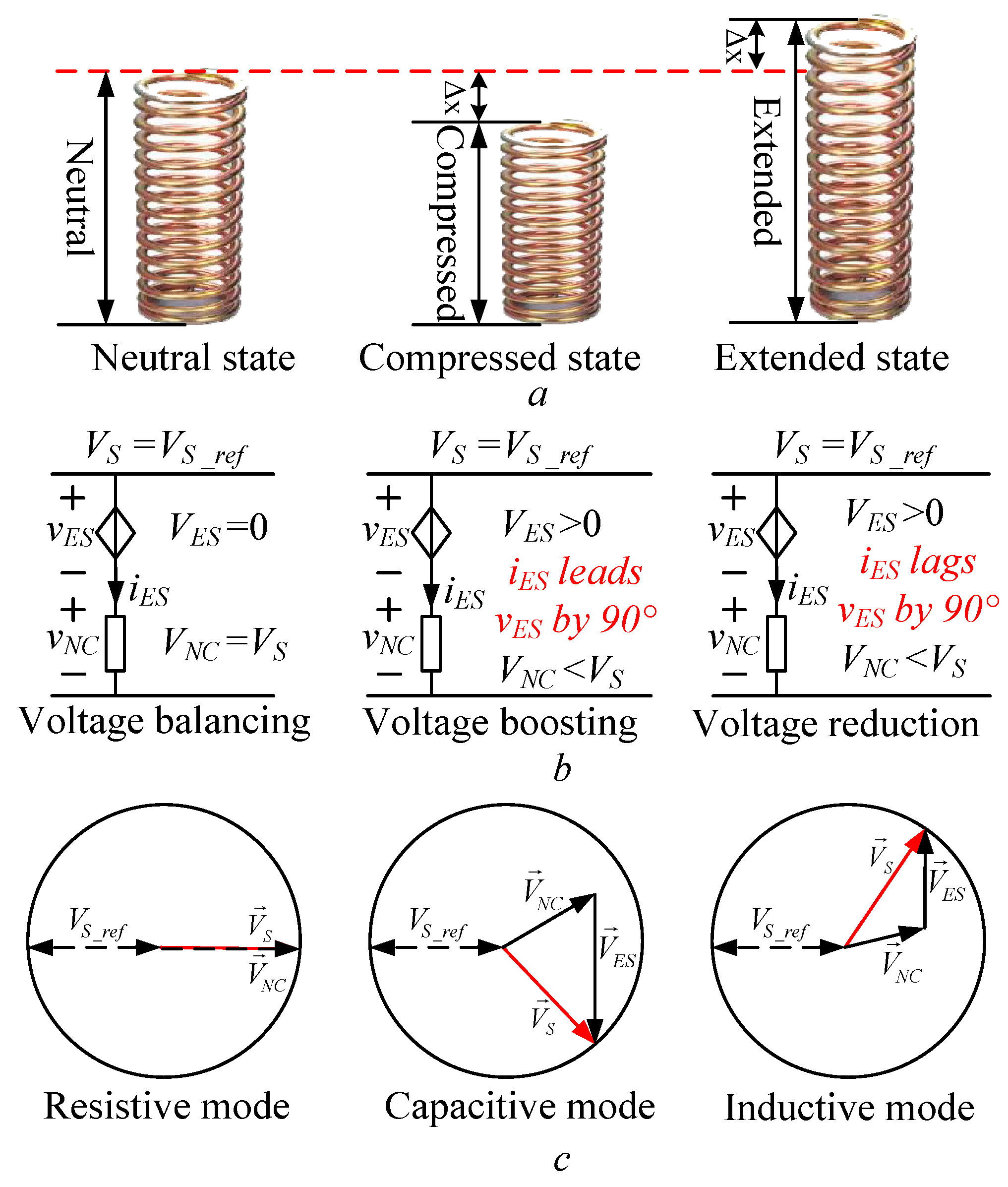
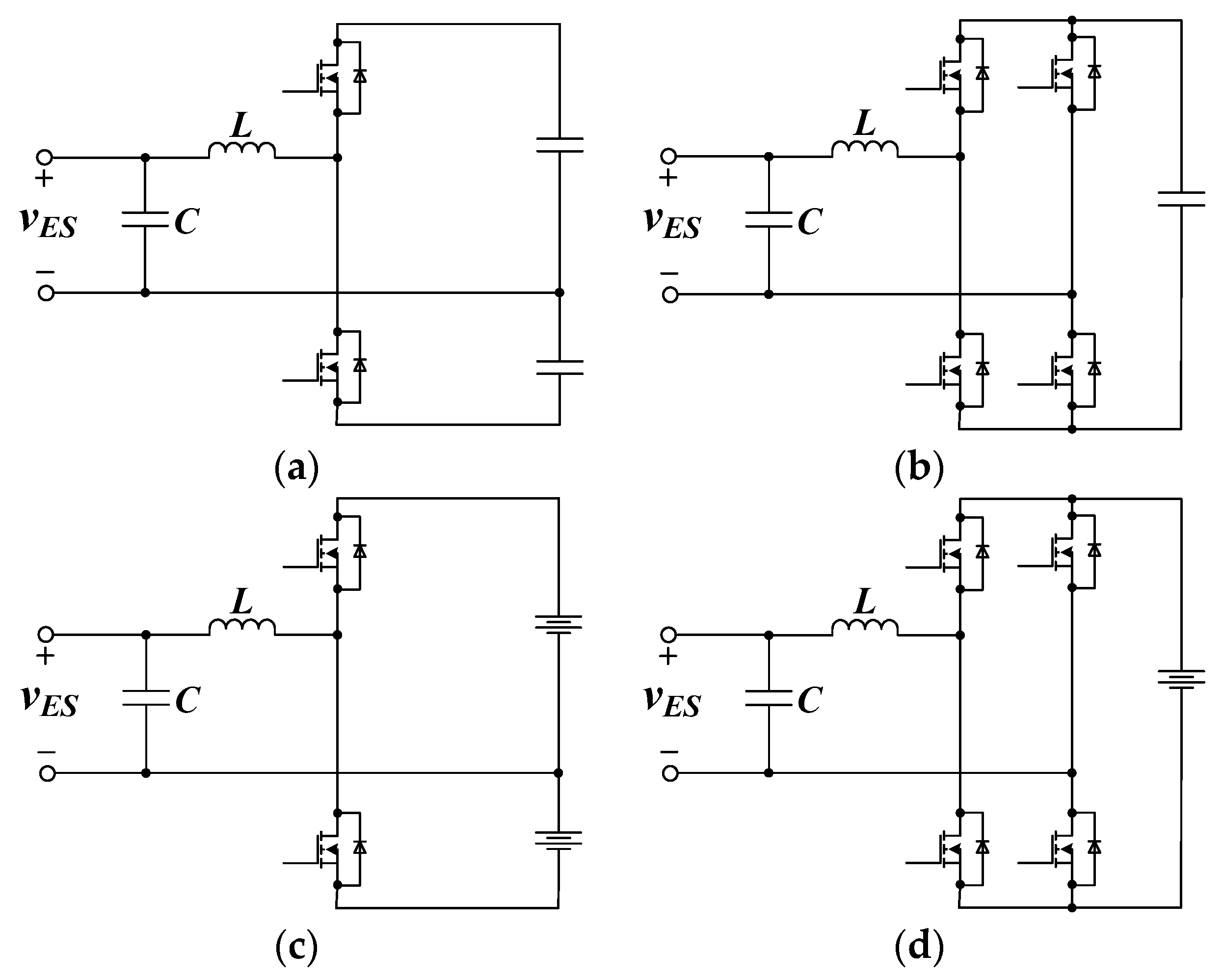

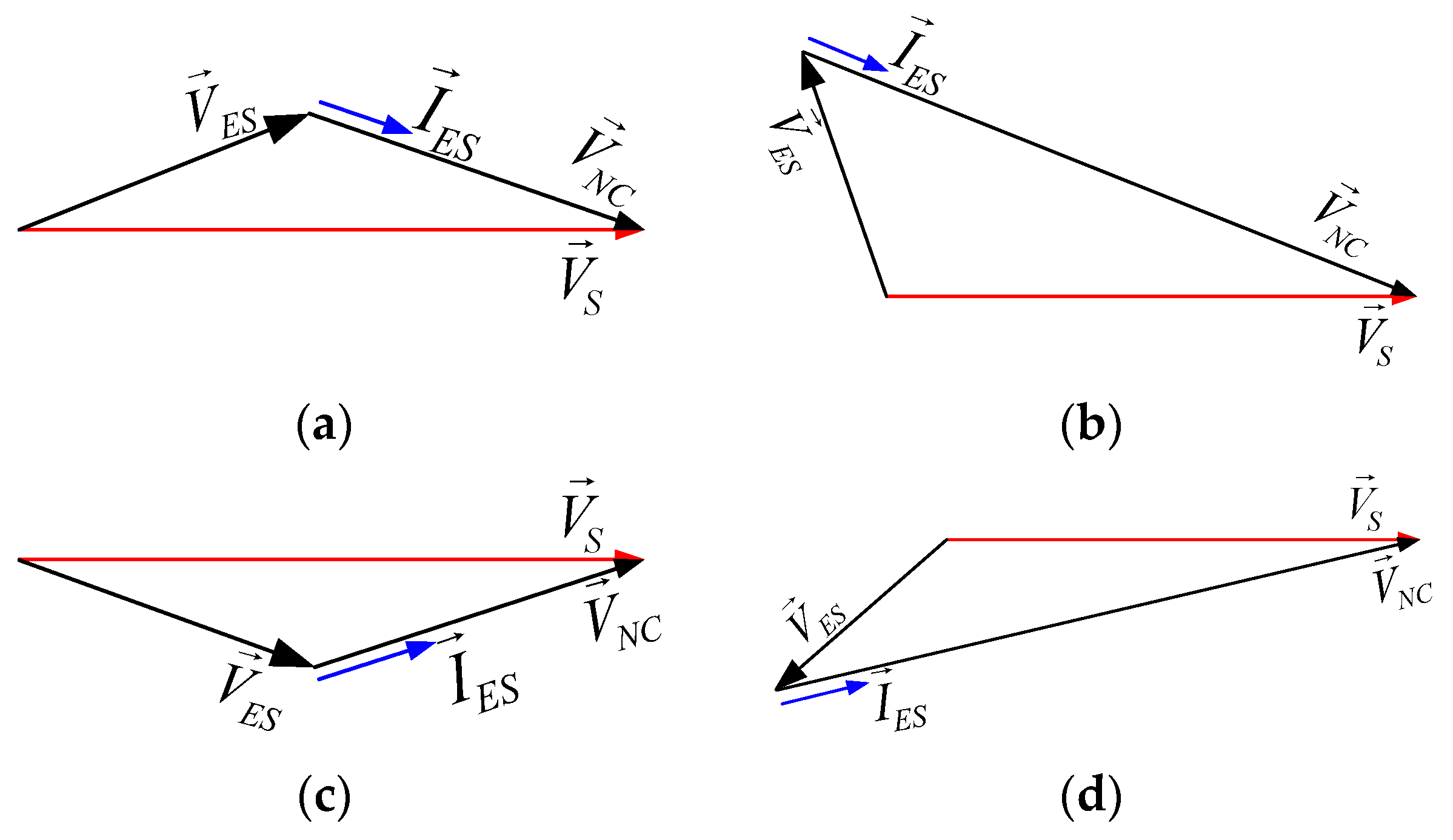
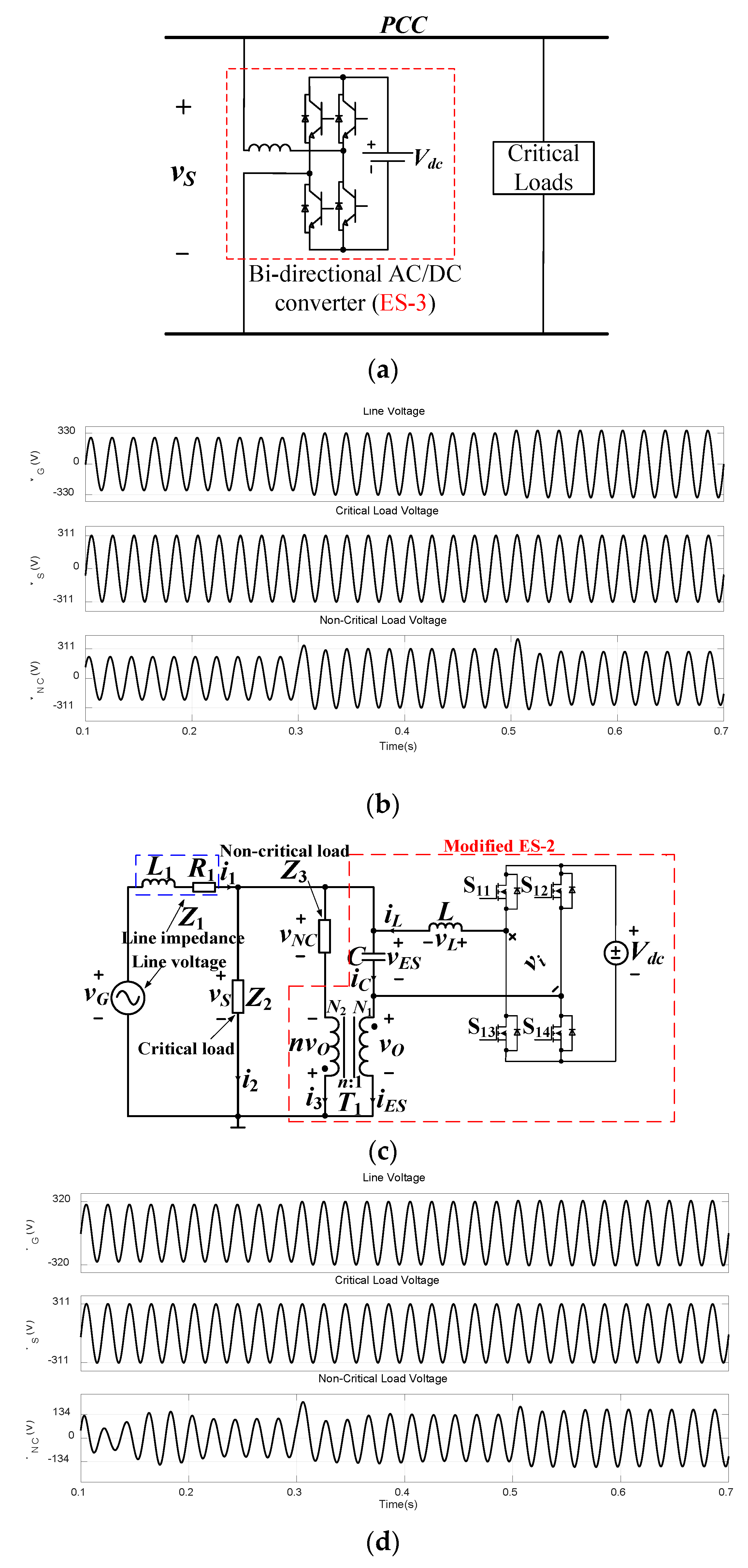
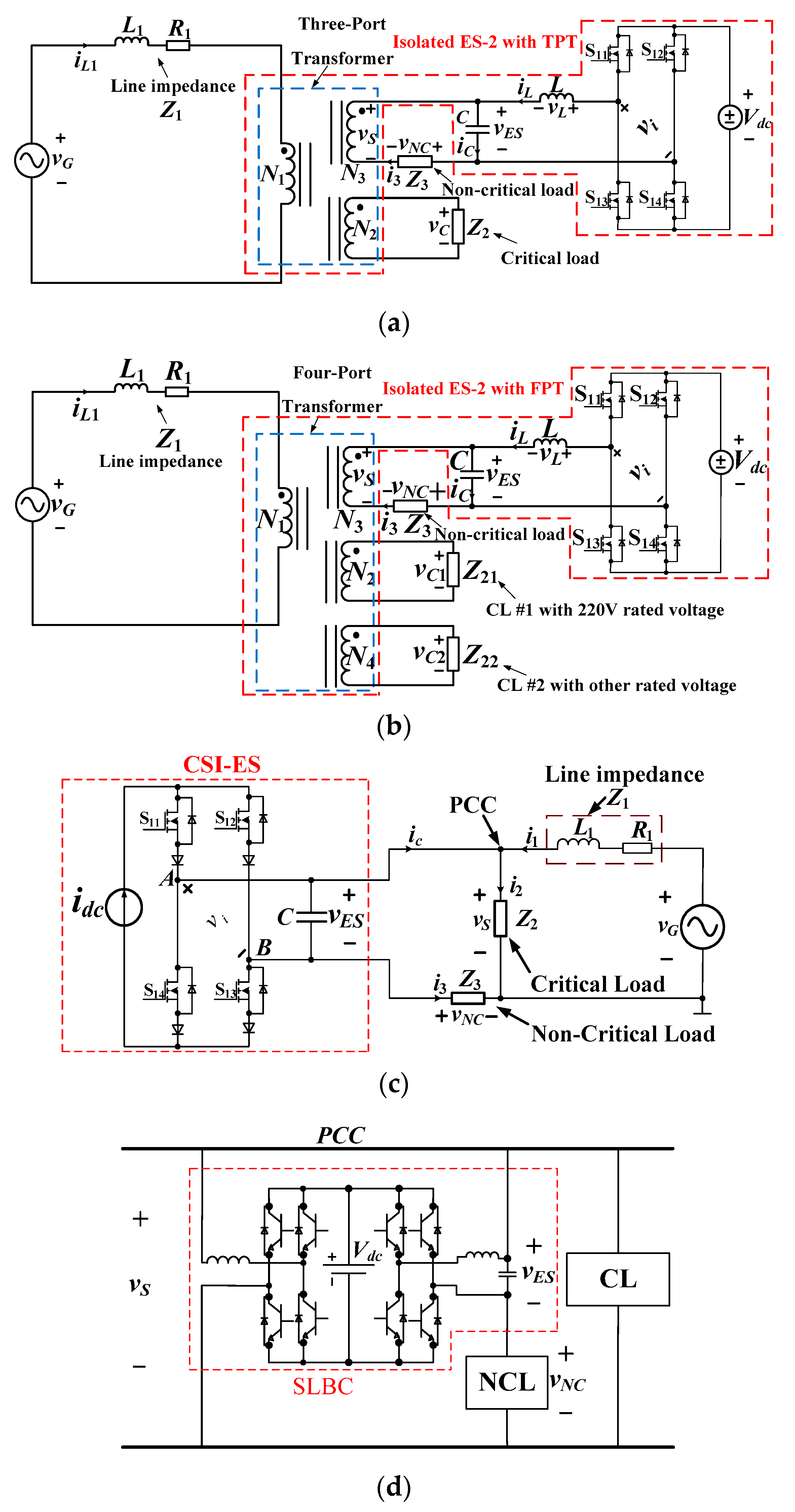
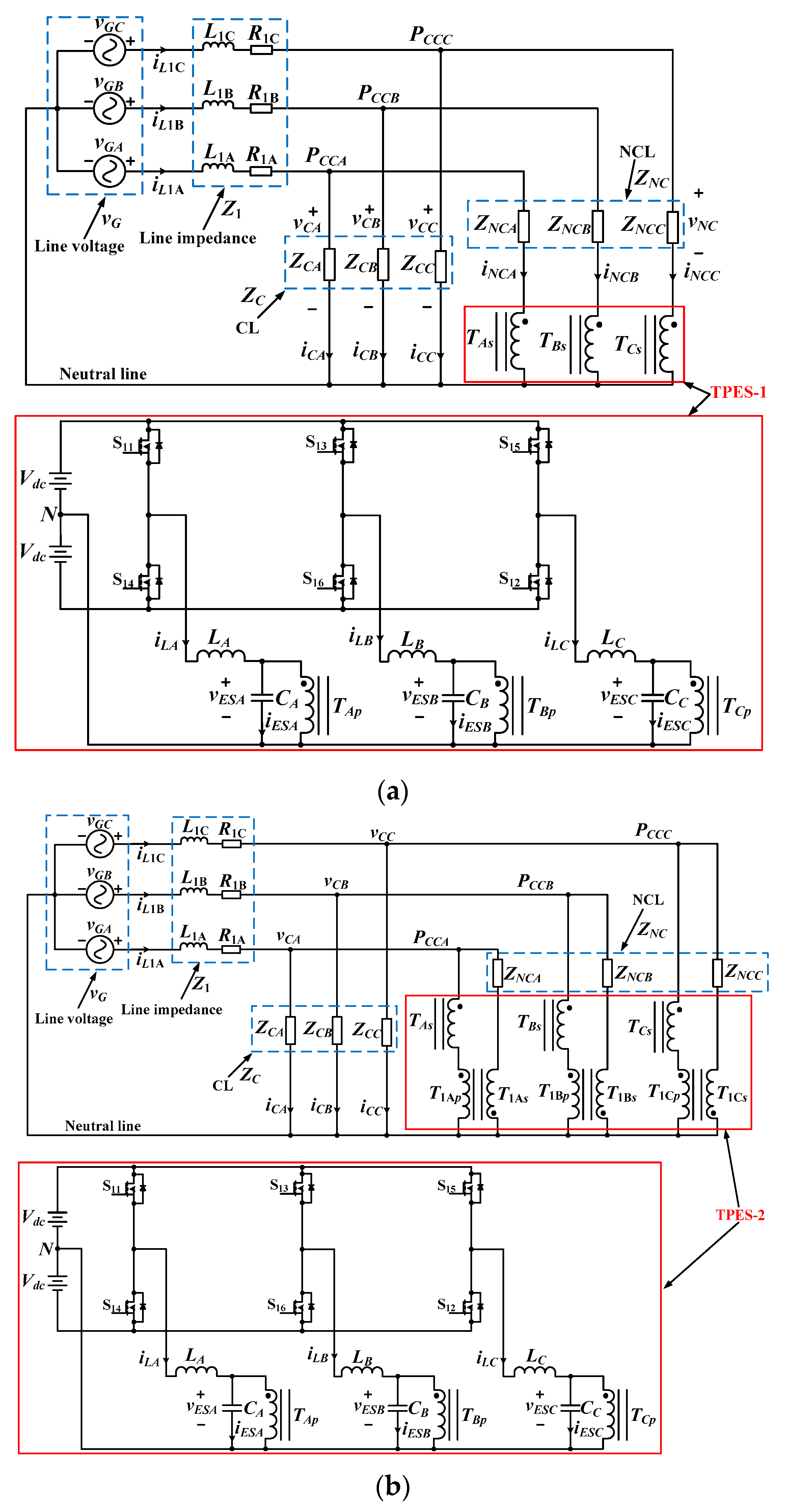

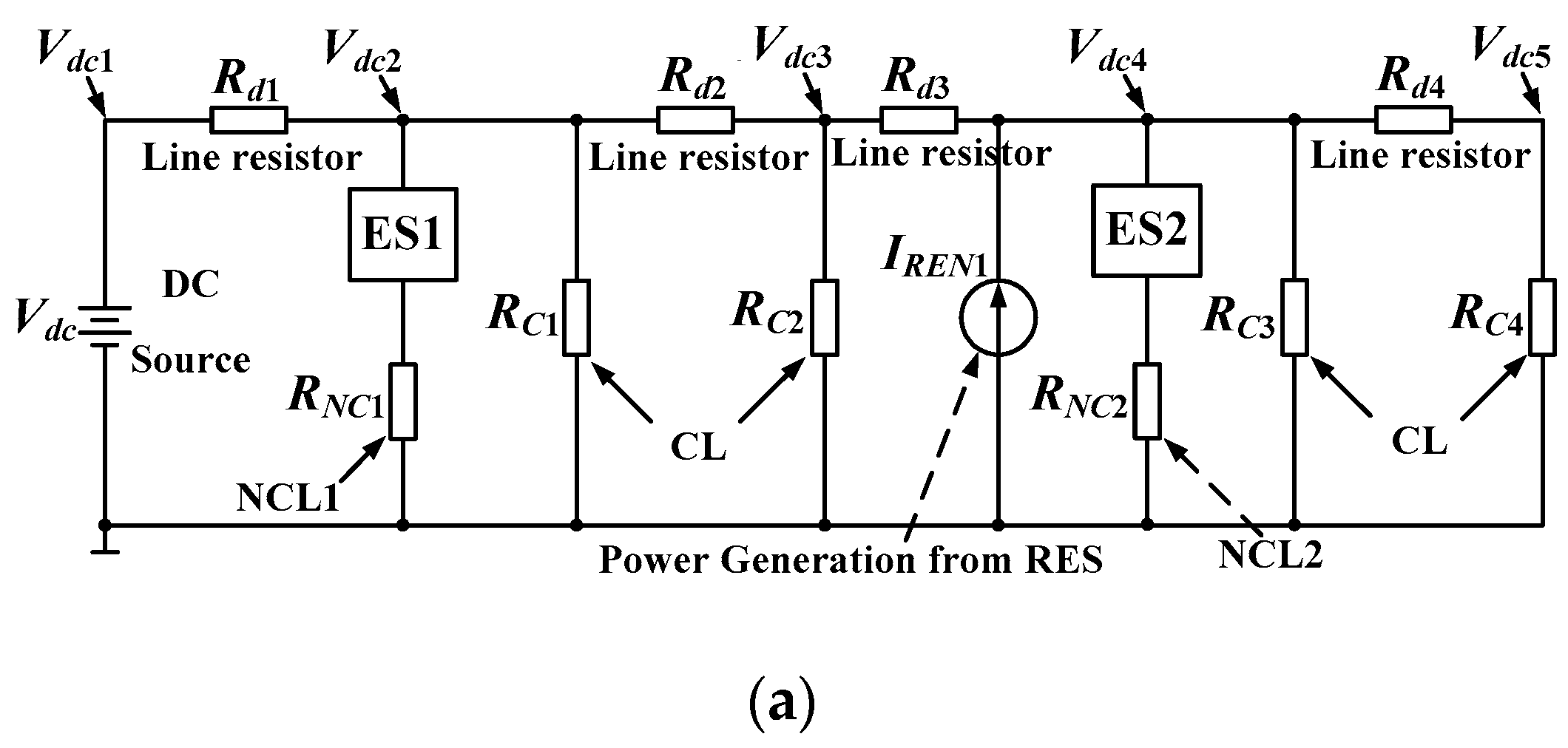

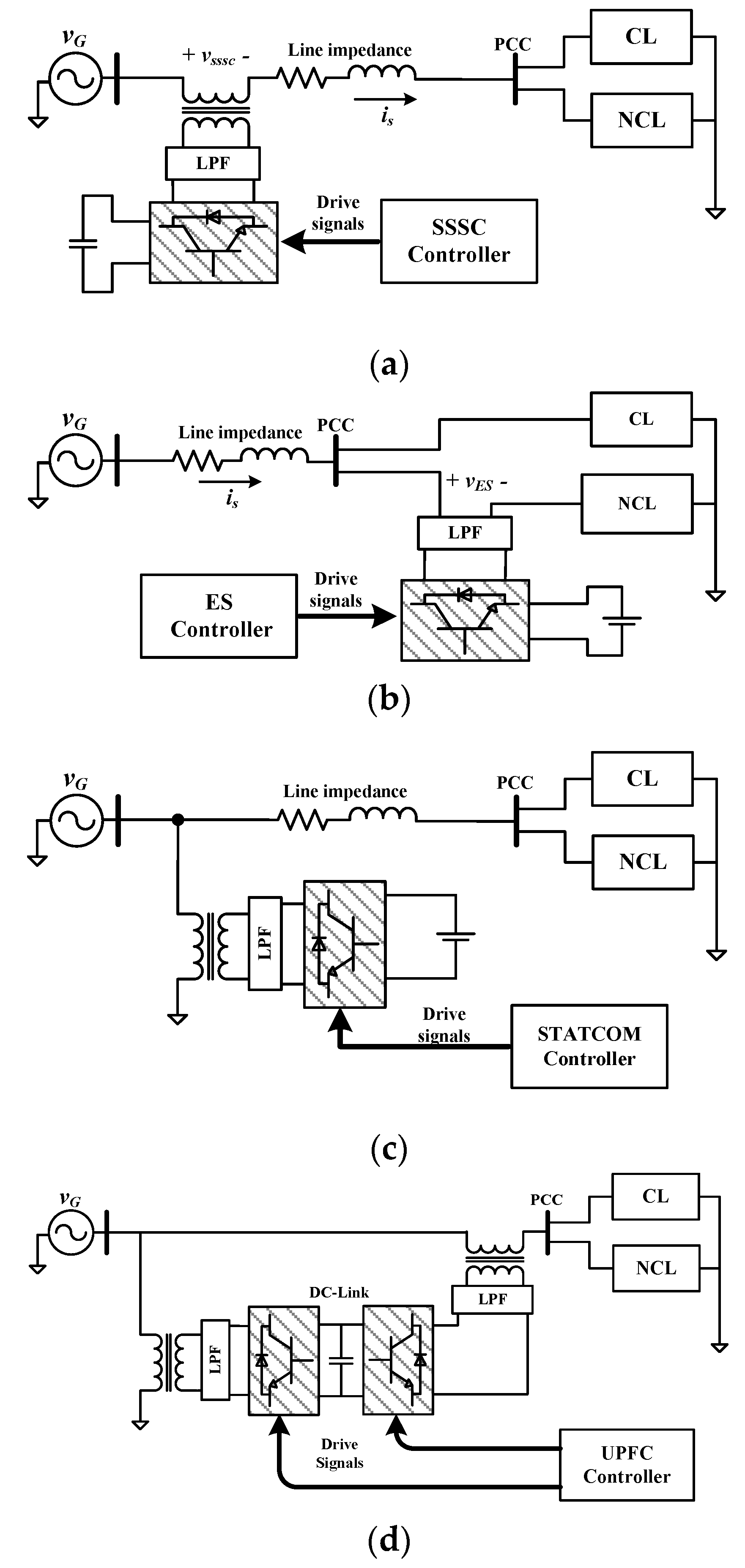
| ES Versions | Characteristics | Advantages | Disadvantages | Possible Applications |
|---|---|---|---|---|
| ES-1 | Capacitor in the DC side of VSI | The simplest version | Cannot regulate active power, NCL is in series with ES | Applications requiring only pure reactive power compensation |
| ES-2 | DC voltage source or batteries in the DC side of VSI | Can regulate both active power and reactive power | NCL is in series with ES | All the possible applications |
| ES-3 | No NCL | Not series connection | No NCL, different with the initial ES concept | All the possible applications |
| Modified ES-2 | Modified version of ES-2 with an additional transformer added | Can achieve different operating functions | Power density is lower than normal ES-2, cost up | Applications with NCLs that have low voltage and power ratings |
| Isolated-ES-2 | Fully-isolated version of ES-2 with a multi-port transformer | Input voltage source, CL and SL are electrically isolated; Can achieve more functions than ES-2 | Power density is lower than normal ES-2, cost up | All the possible applications, except that requires high power density |
| CSI-ES | The first version realized by CSI | Direct current control can be used; Easier to understand ES | Need to generate DC current source first | Applications with CSI input and mature SMES technique and devices |
| SLBC | DC voltage source being replaced by PWM rectifier | No DC voltage source or batteries | Might meet with power sag | All the possible applications, except the case with insufficient input power |
| To be continued | / | / | / |
| ES Versions | Characteristics | Possible Applications |
|---|---|---|
| TPES-1 | Basic topology, the extension of ES-2 | All the possible applications compensation |
| TPES-2 | The extension of Modified ES-2 | Applications where NCSs have low voltage and power ratings |
| TPES-3 | The extension of Isolated ES-2 | Applications where power density is not the key consideration |
| TPES-4 | The simplified version | Applications that require cost-effective and compact size in hardware |
| ES Versions | Connection Type | Control Method | Other Characteristics |
|---|---|---|---|
| ES-2 | Series | Input voltage control [12] for CL, output control for NCL; Distributed control | Transformer optional |
| SSSC | Series | Output control; Centralized control | Transformer needed |
| STATCOM | Parallel | Output control; Centralized control | Transformer needed |
| UPFC | Series and parallel | Output control; Centralized control | Transformer needed |
| APF | Mainly parallel | Output control; Centralized control | Transformer needed |
© 2018 by the authors. Licensee MDPI, Basel, Switzerland. This article is an open access article distributed under the terms and conditions of the Creative Commons Attribution (CC BY) license (http://creativecommons.org/licenses/by/4.0/).
Share and Cite
Wang, Q.; Deng, F.; Cheng, M.; Buja, G. The State of the Art of Topologies for Electric Springs. Energies 2018, 11, 1724. https://doi.org/10.3390/en11071724
Wang Q, Deng F, Cheng M, Buja G. The State of the Art of Topologies for Electric Springs. Energies. 2018; 11(7):1724. https://doi.org/10.3390/en11071724
Chicago/Turabian StyleWang, Qingsong, Fujin Deng, Ming Cheng, and Giuseppe Buja. 2018. "The State of the Art of Topologies for Electric Springs" Energies 11, no. 7: 1724. https://doi.org/10.3390/en11071724
APA StyleWang, Q., Deng, F., Cheng, M., & Buja, G. (2018). The State of the Art of Topologies for Electric Springs. Energies, 11(7), 1724. https://doi.org/10.3390/en11071724








